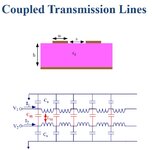yefj
Advanced Member level 4
Hello, i have read the following article and i have a basic missunderstanding regarding imagining the physics of coupling in such case.
i know from coupler that as two lines here are closer then we have stronger coupling.
so in this case we need to tranfer the maximal amount of energy from the line to the patch.
in the article they dont specify
1.the role of the substrate height
2.the role of substrate permitivity
3.the role of the width and legth of the slot for the coupling.
they only say ,we get good coupling for measures of such and such without getting into the reasons of why?
Why the coupling is increasing or decreasing from each case?

i know from coupler that as two lines here are closer then we have stronger coupling.
so in this case we need to tranfer the maximal amount of energy from the line to the patch.
in the article they dont specify
1.the role of the substrate height
2.the role of substrate permitivity
3.the role of the width and legth of the slot for the coupling.
they only say ,we get good coupling for measures of such and such without getting into the reasons of why?
Why the coupling is increasing or decreasing from each case?
